
Solar panel systems, also called PV-systems, are making their way to the roofs of many warehouses, commercial properties, offices or public facilities in Europe and around the world. With the discussions about climate change and the switch to renewable energy sources, the demand for solar panels will only continue to rise.
The goal of this post is to explain a consideration that is often overlooked when planning the layout of solar panels on a roof: fall hazards. After all, to keep solar panels working optimally, they will need periodic maintenance. So, how can solar panels be combined with fall protection to maximize value and minimize risks?
Where to place solar panels
On a flat roof, a user can safely work inside the safe zone in the middle of the roof*, without using fall protection. When calculating the optimal yield of solar panels, it frequently happens that it is required to install them outside the predetermined safe zone. For work on solar panels located outside the safe zone, workers should be protected against falls.
The challenge with solar panels and roof safety
The permanent impact that a PV-system has on the fall hazards on the roof is often forgotten or underestimated. Even if solar panels are only placed inside the safe zone, they can still drastically increase a roof worker’s exposure to fall hazards.
An extensive PV-system greatly reduces the amount of free walking space. The walkways of workers will shift towards the roof edges (or other unsafe areas), even if the actual work doesn’t take place there. Workers will always prefer spacious walkways. Also, they may want to avoid coming near the solar panels because they’re afraid of damaging them.
*A safe zone can NEVER contain unsafe skylights or fragile roof surfaces.
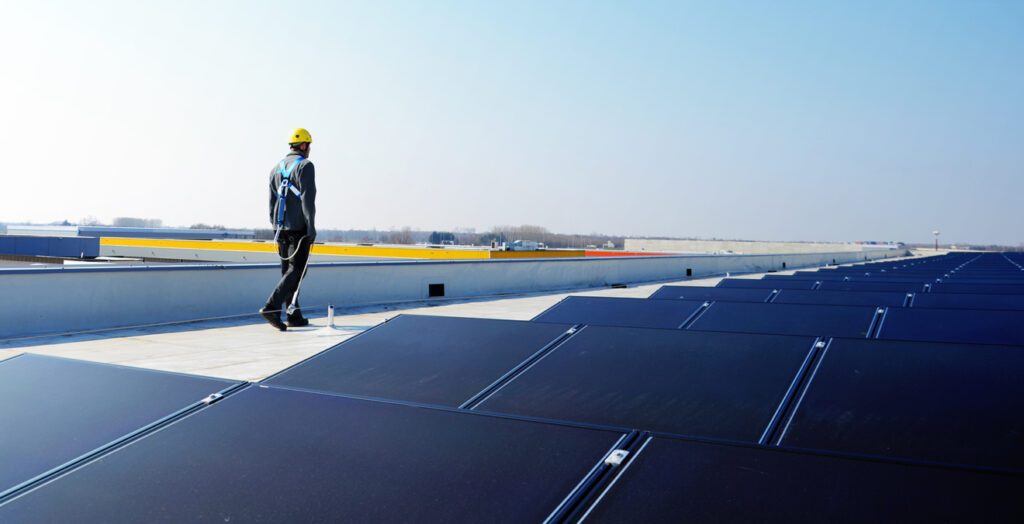
The right type of fall protection
When it comes to fall hazards, it’s always important to look at the bigger picture. Many building owners aren’t aware of all the jobs that require access to the roof. In addition to the installation of the solar panels, this includes cleaning, maintenance and repairs, as well as work on lightning conductors, security camera’s, air conditioning units, antennas etc.
After considering all the jobs that take place on the roof, many building owners reach the conclusion that in the long term, it’s not cost-effective to rely on temporary solutions every single time that roof access is required.
The question that remains is: what kind of permanent fall protection system works best? Without exception, regulations prescribe that fall prevention should always be preferred.
Guardrails ★★★★★
The first solution that may come to mind is a system of guardrails. This solution transforms the entire roof into a safe zone. Because guardrails offer fall prevention and require no user knowledge, they should always be preferred from a safety-point-of-view. With guardrails along the edges, all of the available space on the roof can be used for safe walkways and the placement of solar panels.
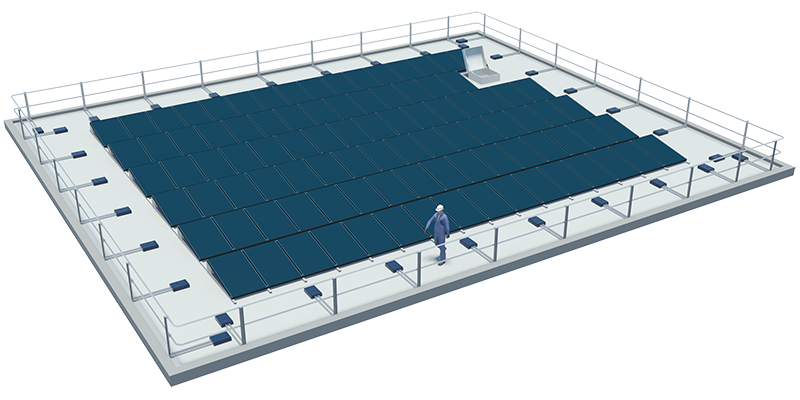
Guardrails: collective fall protection that turns the entire roof into a safe zone, but hinders work in the vicinity of the roof edges.
This might sound like the perfect solution and in most cases, it is. But in some cases, guardrails may not be the preferred option: they may be in the way for certain other jobs that have to be executed near the roof edge, such as cleaning the gutter or maintenance to security camera’s, lighting, or billboards.
Shadow Effect
Solar panels are usually connected in series, especially in larger PV-systems. This means that the shadow of the guardrails on just one solar panel will have a negative effect on the output of all the other panels in the string. To eliminate this effect, collapsible guardrails are recommended for roofs with solar panels. That way, the efficiency of the PV-system is only reduced when the system is used.
Horizontal Lifeline Systems
With a lifeline system, a user wears a harness that is connected to a slider which runs over the lifeline (or anchorage line). It’s important to distinguish between the two ways to use this system: fall arrest or restraint.
A lifeline does not obstruct jobs that take place at the edges of the roof. When used correctly, it is an effective fall protection solution that protects users outside the safe zone. However, a lifeline solution can only be implemented if users are able to connect to the lifeline inside the safe zone.
At XSPlatforms, we’ve defined two ways two set up a horizontal lifeline system on a flat roof:
Horizontal lifeline along roof edge ★★★★
A horizontal lifeline can be installed at a fixed distance along the roof edge, at the boundaries of the safe zone**. This setup is preferred in terms of usability and clarity. Workers can use a lanyard with a fixed length to connect to the lifeline, which restrains their movement. This way, the horizontal lifeline can offer fall prevention.
** Local rules & regulations apply. Ask one of our fall protection experts.
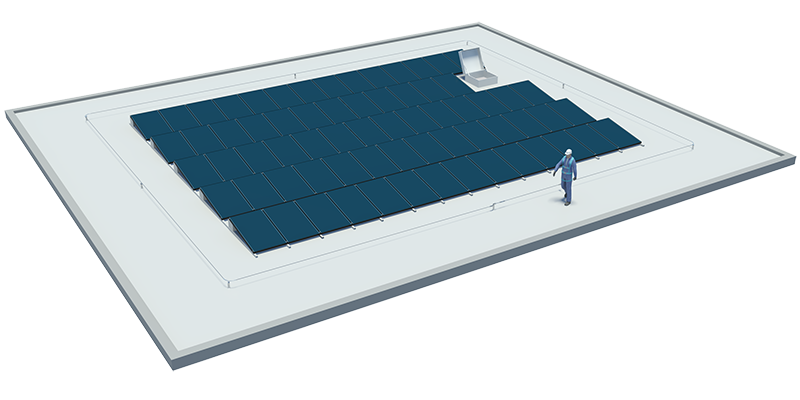
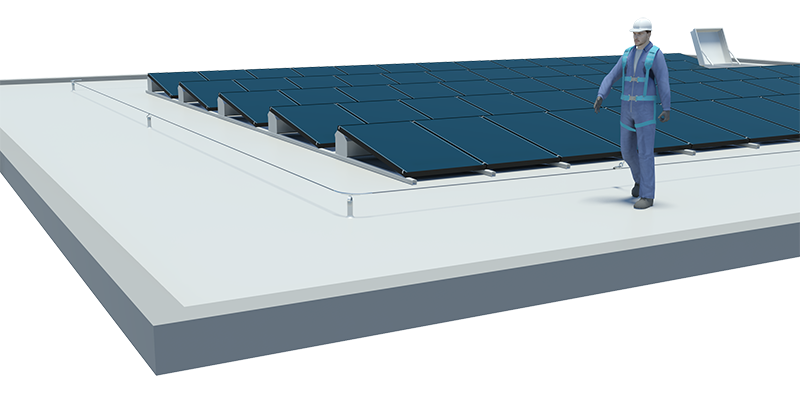
Horizontal lifeline along roof edges: an easy-to-use personal fall protection setup that facilitates work at the roof edges. Usage of the lifeline is only required for work outside the perimeter of the lifeline.
Horizontal lifeline in the middle of the roof, with anti-pendulum anchors ★★★
A horizontal lifeline can also be placed in the middle of the roof. With this setup, the use of anti-pendulum anchors (in conjunction with the lifeline) is required in areas where swing fall hazard exists, such as the roof corners.
This setup is only applicable on roofs up to a certain width**. Workers will have to work with an adjustable lanyard that runs all the way over the roof (and over the solar panels), which entails a greater risk of misuse. Also, the anchors of the horizontal lifeline may have to be extended, to raise the lifeline above the height of the solar panels.
** Local rules & regulations apply. Ask one of our fall protection experts.
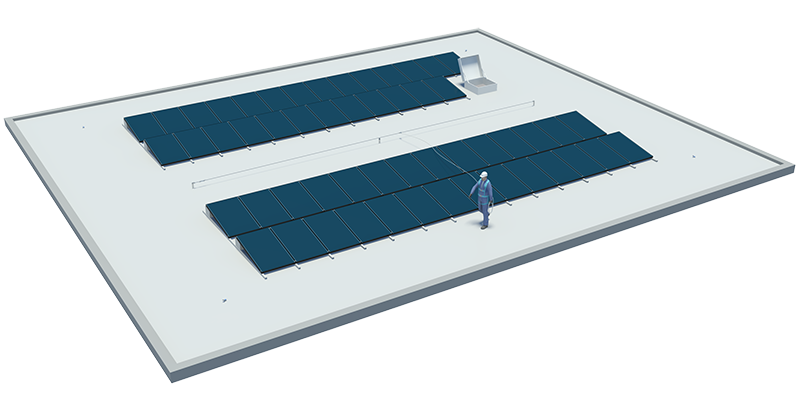
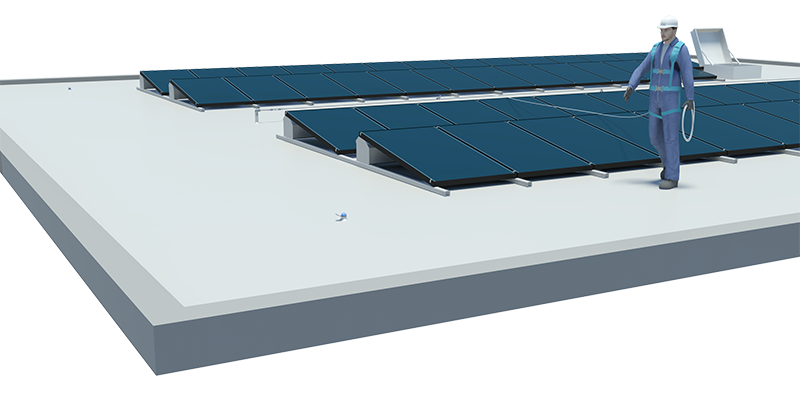
Horizontal lifeline in the middle of the roof: a personal fall protection setup that offers limited usability and requires more user knowledge, partly due to the use of anti-pendulum anchors.
In conclusion: building owners who plan to install a PV-system should consider the permanent negative impact that the solar panels on the roof have on the safety of roof workers. An investment in permanent fall protection may be needed to secure a worker’s walkways. Guardrails may even make more room for extra solar panels.
Roof lights
Roof areas that contain roof lights or other fragile surfaces entail a risk of workers falling through the roof. These areas can never be considered a safe zone. When planning the layout of a fall protection system on a roof that contains roof lights, a number of other factors are to be considered, which we’ll explain in our next blog post.
More Information
If you would like more information about our fall protection solutions, request our fall protection brochure. For advice about the most suitable fall protection solution for your building or project, it’s best to contact us directly.